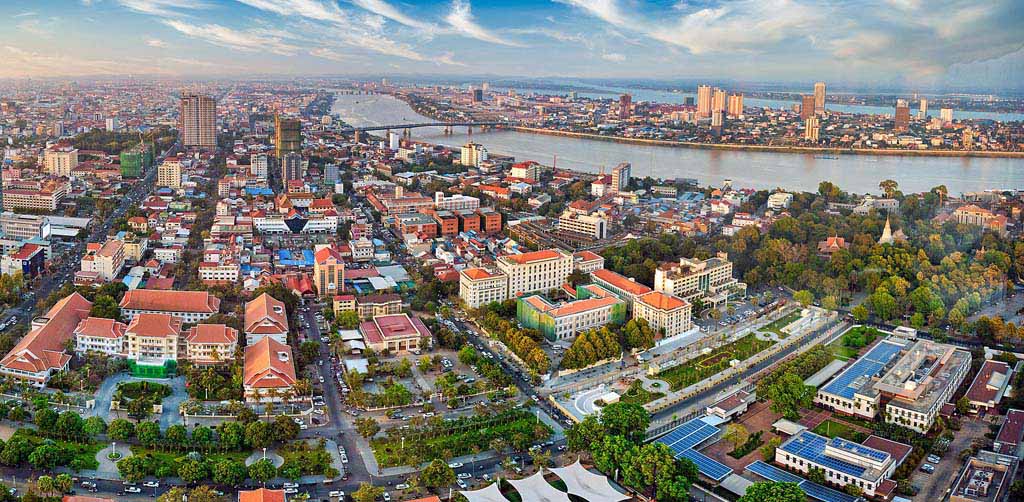Phnom Penh
With an international airport now open in Siem Reap, most travelers now bypass the sleepy capital which is a missed opportunity, for the capital is a vibrant place place with new restaurants, cafes and hotels opening in rapid succession and where can can observe authentic Khmer culture rather than ruins of their past. Phnom Penh is a must stop if you're hoping to catch an authentic glimpse of contemporary Khmer culture.Phnom Penh exudes an eccentric charm. Seen from the river, palm trees, and the pagoda-like spires of Khmer royal buildings rise over French-era shop houses and villas. In the 1950s and 1960s this was one of the finest cities in Southeast Asia. The riverine city's yellow-ocher buildings, squares and cafes, and frangipani-lined boulevards give it the atmosphere of a French provincial town. The city is located at what the French called les Quatre Bras (the Four Arms), where two arms of the Mekong meet the Bassac and Tonle Sap tributaries. The city's original name, Chaktomuk, means Four Rivers.
Phnom Penh has witnessed rapid and bizarre changes of fortune. After Angkor fell to the Siamese in the 15th century, Cambodian King Ponhea Yat founded a new capital at Chak-tomuk. This city was soon abandoned as well, ; and from the mid-17th to mid-19th centuries the Cambodian capital was in Udong, 40 kilometers northwest of Phnom Penh. King Norodom moved the capital to Phnom Penh in 1866. The city is largely a French creation-even the Khmer-style buildings and temples were built under French supervision. Wide boulevards and stately mansions were constructed in the French colonial era, and Phnom Penh quickly became an important commercial center. The city was and still is-the only major port on the Mekong above the delta; it is navigable by ships of up to 7,000 tons.
In the late 1960s prosperous Phnom Penh had a population of perhaps 600,000. Almost two-thirds of the population consisted of Vietnamese and Chinese merchants and workers. The Chinese, Vietnamese, and Khmer ethnic groups occupied their own distinct neighborhoods. Business and trade congregated in streets of their own, with sections devoted to basket making and silversmithing. By 1975, swollen with refugees from civil war, the city had a population of over two million.
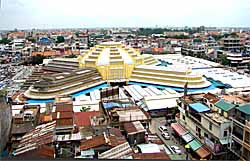
Khmer Rouge Era
On April 17, 1975, Phnom Penh became a ghost town, emptied out by the Khmer Rouge within 48 hours. During the 1975-1979 reign of terror, the city's inhabitants were mostly soldiers and prisoners. By 1978 there were only 15,000-30,000 people in the city. The Khmer Rouge painted over all signs in Phnom Penh traffic signs, advertising signs, markers of any kind. Wrecked cars lay where they were abandoned in 1975. All shops and hotels were closed. A number of buildings were blown up or demolished, including the Catholic Cathedral and the National Bank. Up to two-thirds of the city's houses were damaged. The plumbing system was destroyed. People started streaming back to the city shortly after the Vietnamese takeover in January 1979; over 100,000 returned in that year alone. The current population is over a million.
The U.N. Period
Phnom Penh was the main base of operation for UNTAC in 1992-1993. The place was swamped with U.N. personnel. Thousands of white UNTAC Land Cruisers, jeeps, and trucks created traffic jams on Phnom Penh's boulevards. After UNTAC came a rush of businesspeople - Thai bankers and Japanese businessmen - to make deals in the fragile peace under the new coalition government. The Japanese funded a major renovation of the Phnom Penh port. Phnom Penh, like the rest of Cambodia, is in a boom-or-bust situation. While peace reigns, tourists and businesspeople come in and the economy does well.
Highlights of Phnom Penh
The city's most esteemed buildings are toward the Tonle Sap River, with French villas and institutions in the north, and the Royal Palace, Silver Pagoda, and other traces of the former royal city to the south. Apart from the more formal sights described here, the markets around Phnom Penh hold the greatest visual and people-watching interest.
The Royal Palace
Since the return of King Norodom Sihanouk in November 1991, the palace has been closed to public viewing. The gates are thrown open for three consecutive days in early November, when the compound becomes a kind of fairground. The rest of the year the palace is off-limits, although it is possible to peek at the palace from various side gates. It occupies a huge block between Streets 184 and 240, facing Samdech Sothearos Boulevard.
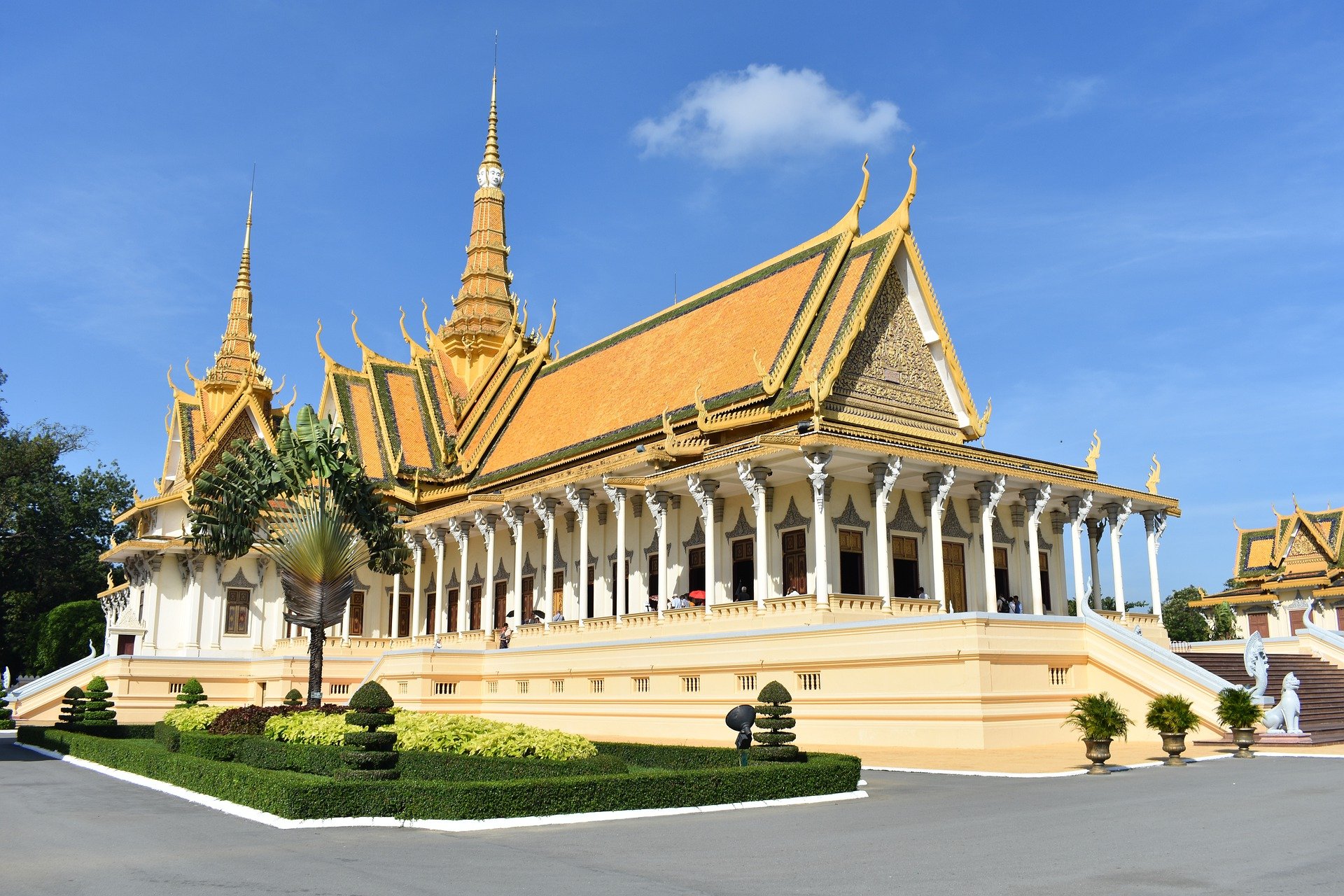
The Royal Palace was built in stages in the early 20th century over the site of Banteay Kev, a 19th-century citadel. A number of the present buildings were built in concrete under French supervision, emulating previous Khmer-style wooden structures. Between 1970 and 1979 the palace was looted and sustained considerable damage. The most accessible feature of the Royal Palace is Chan Chaya Pavilion (Pavilion of Dancers), which fronts Samdech Sot-The southern sector of Phnom Penh close to the Tonle Sap River exudes a strong royal Khmer presence, with a wealth of Cambodian traditional architecture. The city was once rich in temples and many were destroyed under the Khmer Rouge, but some are being reconstructed. This tour starts at War Ounalom, opposite the Phnom Penh Tourism Office.
Wat Ounalom is a Mahanikai Buddhist temple and highly respected institute of learning, with 50 monks in residence; before 1975 there were 500 monks here. This is the residence of the Supreme Patriarch of the Mahanikai sect. The temple was founded in the 15th century; a large number of its buildings were destroyed under Pol Pot, including the library. The temple has since been partially restored. The compound contains two residences, and a three-floor building that functions as a temple; the interiors are stark and bare. On the ground floor is a marble Buddha from Myanmar (Burma)-smashed by the Khmer Rouge, but pieced together again in 1979. On the second floor is a brass statue of the patriarch of Cambodian Buddhism, Somdech Hoot Tat, who was murdered by the Khmer Rouge. The statue, made in 1971, was flung into the river, but retrieved in 1979. On the third floor the walls depict scenes from the Jataka Tales.
From War Ounalom you can skirt round past the National Museum. The museum is notable not only for its outstanding exhibits but also for its superb traditional-style architecture. To do justice to the place, you really need to spend several hours. In this area is the Ecole des Beaux Arts (School of Fine Arts) where students often work on reproductions of famous Khmer artifacts. The souvenir and gift shops in the surrounding blocks are especially good for paintings, wood sculptures, and crafts. The School of Fine Arts has its own retail outlet.
Back on Samdech Sothearos Boulevard you can cruise past Chan Chaya Pavilion, which doubles as a front gate to the Royal Palace and a public events podium. Above the pavilion is a huge portrait of King Sihanouk. The Royal Palace is closed to the public-what you glimpse through the gates is about it, unless you arrive in November when the palace is thrown open for three days. At the southern end of the palace grounds, you can drop in and visit the Silver Pagoda. Skirt the walls of the palace and head south to Wat Botum.
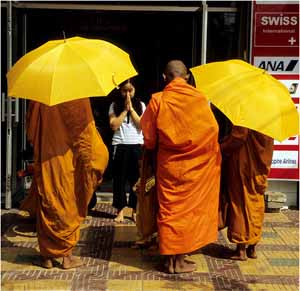
Buddhas and Bayon Heads
Wat Botum is known as the "Temple of the Lotus Blossoms"-the original site was a small island surrounded by a lotus-filled pond. This temple is the center of the Thammayut (royalist) sect of Buddhism in Cambodia. The royalist sect has been revived since the return of Sihanouk; about 85 monks now reside at War Botum. In July 1992, more than 150 bonzes (monks) were ordained here. At the front of the temple is an unusual cluster of stupas with Bayon-style four-headed tops; the ceremonial stupas hold the ashes of members of the royal family.
Opposite War Botum in a park is the Liberation Monument, carved from Angkor marble by the staff of the School of Fine Arts in 1989 to commemorate the 1979 liberation of Phnom Penh by Vietnamese troops. Proceed south and turn onto Preah Sihanouk Boulevard to see some of the best preserved colonial mansions and manicured gardens in Phnom Penh. Over the boulevard to the west is the Independence Monument, looming like a kind of Cambodian Arc de Triomphe. Also called the Victory Monument, this Khmer-style prasat (tower) was built in 1958 to commemorate independence from France, but has since assumed the role of a war memorial. Wreath-laying ceremonies honor the dead. Like the towers of Angkor War and the four-headed spires of the Bayon, the monument is a national logo.
From the Independence Monument you can detour about 300 meters south to the Prayuvong Buddha Factory. In the grounds of War Prayuvong, a neighborhood of workshops produces statuary and "spare parts" used in repairing temples smashed by the Khmer Rouge. The workshops turn out stupas and Buddhist artifacts, including gaudy cement Buddhas, Bayon heads, nagas, and mythological figures. You can walk around the various workshops and watch the artisans at work.
Waterfront Pavilion
Locals turn out for a stroll at the end of the day past the tiny slope-roofed pavilion fronting the Tonle Sap River, opposite the Royal Palace Gates. At sunset impromptu picnickers frequent the place; police pursue food vendors up and down Sisowath Quay. Cyclo drivers arrive for river baths, and roving photographers work the crowds. This is an excellent place to mingle. There are two shrines for offerings of garlands of jasmine and coconuts spiked with incense sticks and lotus buds. North of the pavilion are many sidewalk vendors. For drinks, try a beer stall x on the banks of the Tonle Sap. For a more refined drink, the Foreign Correspondents Club of Cambodia (FCCC) top-floor bar is a colonial-era throwback, with swishing fans and elegant furnishings. The bar affords great views over the river.
Built in 1913, it served as public events podium, a venue for music an dance performances on special occasions, an for speeches by the king. King Sihanouk put the podium to royal use again for the celebration o the 40th anniversary of independence in 1993 Under the pavilion is the main entrance gate t the palace, which is closely guarded.
Depending on the mood of the guards, yo might be able to peek through the gates. Buildings at the palace include the Royal Residence d (Khemarin Palace), built in 1930; an Officers' I Club, built in 1958 for officers of the royal guard; and Phochani Hall, built in 1913 for performances of royal dance. The Throne Hall, topped . by a four-headed tower (inspired by Angkor's Bayon Temple), was completed in 1917 under King Sisowath. The glazed tiles on the layered roof were added in 1993 during a German-funded renovation project.
The hall, once used for coronations, is now employed for traditional ceremonies and official receptions. In the center are thrones for the king and queen, and seats for court officials. The walls are decorated with Ramayana murals. The king and queen were once ferried around for royal processions in sedan chairs or gilded wooden chariots, and sometimes by elephant. An elephant-mounting pavilion is located just north of the Throne Hall; elephants were previously stabled within the grounds.
From the barred gate along the alley entryway to the Silver Pagoda you can see an ornate gray French pavilion. This was originally presented by Emperor Napoleon III to Empress Eugenie during the Suez Canal opening celebrations in 1869. The prefabricated summer house was then dismantled and packed off to Cambodia as a gift to King Norodom. Erected at the Royal Palace in 1876, the structure was renovated by a group of French volunteers in 1990. The Royal Offices stand just behind this building, built in 1948 and used as a residence by the Regent. Beyond you can see the outlines of the Throne Hall.
Silver Pagoda
The Silver Pagoda is the royal chapel, located within the Royal Palace grounds but walled off in a separate enclosure. The pagoda was built in 1962, replacing an earlier 1892 version. After suffering damage and neglect in the Pol Pot era, it is cracked and peeling. The temple is intermittently closed due to restoration work, ongoing since 1993. The Silver Pagoda takes its name from the estimated 5,000 silver tiles covering the floor of the main temple. Each tile is made from a kilogram of silver. Although plundered by the Khmer Rouge, the Silver Pagoda contains some superb Buddha statuary; a few artifacts from the royal collection are displayed in glass cases.
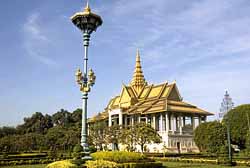
Near the central dais in the main temple is a standing Buddha, made of pure gold and weighing in at 75 kilograms. The Buddha isn't simply life-size-it conforms to the vital statistics of King Norodom. The image was made in 1907 in the royal workshops, inlaid with over 9,000 precious stones, including diamonds studded on the forehead and palms. Companion statues include a silver and a bronze Buddha.
On the central dais sits a crystal Buddha image, copied from Pra Keo, the Emerald Buddha, at Bangkok's Grand Palace. The Emerald Buddha is regarded throughout Southeast Asia as a powerful talisman, imbued with miraculous powers. The inspiration for the Silver Pagoda is believed to be Bangkok's War Pra Keo. In Khmer, the Silver Pagoda is known as Preah Vihear Keo Morakot because it houses the Emerald Buddha knock off.
At the rear of the dais is a standing Buddha made of Italian marble. Right at the back of the pagoda is a large marble Buddha in the Earth Witness pose, a gift from Myanmar (Burma). Beside it is a litter used for coronations-it was carried by a dozen men. More coronation regalia and dozens of smaller statues are displayed here.
In the courtyard of the Silver Pagoda compound are four large stupas (shrines) built by the Norodom family. The original temple arose during the reign of King Norodom-the stupas to the northeast is dedicated to him, and there's an equestrian statue of the king nearby. Actually, it's a statue of Napoleon III with Norodom's head. Three other stupas in the compound are dedicated to Norodom royal family members; the stupas to the southwest commemorates Sihanouk's favorite daughter, who died of leukemia in 1953. The others honor Sihanouk's father, King Norodom Suramarit, and the 19th-century king, Ang Duong. Also in the courtyard is a bell tower, a library that once contained manuscripts on palm leaves, and a pavilion used for celebrations by the royal family. There are two Buddha footprint pavilions-one footprint is made of bronze and comes from Sri Lanka.
Running the length of the walls enclosing the compound are 600 meters of covered galleries. Starting at the east gate and proceeding in a clockwise direction, the galleries depict episodes from the Reamker. The murals are in bad condition due to water damage and neglect-a Polish government group is restoring them.
Touring the French Quarter
Might as well go straight to the heart of Phnom Penh: step right up and meet Madame Penh herself. She's the revered figure encased in a tiny shrine on the top of Wat Phnom, the temple on the hill overlooking the city from the north end of Norodom Boulevard.
War Phnom is the oldest temple in town. Legend has it that in the 14th century a wealthy widow, Madame Penh, discovered four statues of Buddha in a tree trunk that washed up on the riverbank. It turned out that these Buddhas originally came from Laos and were miraculously carried downstream by a flood. With the help of villagers, Madame Penh built a small pagoda to house the images. Phnom means "hill," so this is the hill of Madame Penh. The name was later transferred to the settlement that grew up around the hill.
The residents of Phnom Penh make offerings of fruit, flowers, incense, and money at this small shrine. They come to this and other small temples on the hill to pray for protection on journeys, success in exams or the lottery, or healing from sickness.
The eastern stairway is the most dramatic approach to this sacred area. There are two huge five-headed nagas sliding down the stairs here, beggars and bird sellers line the steps (aggressive child beggars are rife). Purchased birds are released for luck or merit making, and are quickly recaptured. At the top of the steps is the main temple; out back is the tiny Madame Penh shrine, and to the south side a massive stupas. The stupas is said to contain the ashes of Ponhea Yat, the post-Angkorian king who made Phnom Penh his capital.
Eventually Madame Penh's pagoda was replaced by larger temples, built in 1806, 1894, and 1926. The main temple houses a resplendent seated Buddha. The exterior features painted Angkor apsaras in relief; a series of frescoes on the life of Buddha cover interior walls. Worshippers make their rounds, leaving incense at various shrines or offering food for blessing before it's taken home to the family table. The Chinese and Vietnamese residents of Phnom Penh have constructed a shrine off to the side. Raw meat and eggs are sometimes placed in the mouths of two lion statues here, near a burner for Chinese-style paper money.
On the north slope of War Phnom once stood a mini-zoo with elephant rides. Now there's a white elephant in the form of an enormous chedi (stupas) . scuttled halfway through construction when it was discovered the foundations were only 10 meters deep, instead of 25. Amid charges of fraud, corruption, and graft, plans for a 50-meter-high chedi were abandoned after a million dollars had been spent on the project, intended to house a sacred bone of the Buddha. There are plans to turn the site into a museum for Buddhist scriptures. On the south slope is a plaque inscribed "Traite Franco-Siamois 1907 Batambang-Siem Reap-Sisopon, Consul de France 1903," commemorating the French-orchestrated return of Siem Reap and Battambang provinces to Cambodia; the French had ceded these same territories to the Thais in 1867. Opposite War Phnom to the northeast is a building that served as UNTAC Headquarters from 1992 to 1993.
French Villas
Proceeding from Wat Phnom north on Street 47 (a.k.a. Rue de France or Vithei France) you encounter a string of villas-the old French residential area, with structures under renovation for use by companies like TNT and Castrol. Some villas here are in great condition, others decayed and crumbling. Turn right on Street 80 toward the Tonle Sap River and follow the banks up to the bridge.
Chruoy Changvar Bridge was built in 1965 and destroyed 10 years later. Until 1993 the initial, spans jutted out from both sides of the Tonle Sap. Enterprising stall vendors set up impromptu restaurants at the very edge of the Phnom Penh side of the blown-up bridge, and motorcyclists would run out for an afternoon snack. The bridge was reconstructed with Japanese aid and reopened in 1994 as the Cambodian-Japanese Friendship Bridge. It leads to fishing villages, farmland, and a popular strip of restaurants on the Chruoy Changvar Peninsula.
Due west of the bridge, along Street 72 is the School of Fine Arts where Khmer dance and music are taught. It might be possible to drop in and observe children being trained in the delicate Khmer dance movements; there are sometimes rehearsals of longer Ramayana pieces here. To one side is an acrobatic ring where young students train for trapeze, acrobatic, and juggling acts.
Returning to the big roundabout to the east, you will notice a bizarre piece of statuary mounted on a dias in the middle of a park at the roundabout. It is the Knotted Gun-a huge handgun made from melted-down firearms-and the barrel tied in a knot. Knot for Use is the message here: the statue was erected by Phnom Penh officials to symbolize a crackdown on gun use and stiffer firearms laws. An odd way to get your message out, but then you have to allow for the fact that this is Cambodia, where people sleep with handguns under the pillow, just in case.
Back on Monivong Boulevard is the French Embassy compound where foreigners took refuge after the Khmer Rouge takeover of Phnom Penh on April 17, 1975. Some 800 foreigners and 600 Cambodians crowded onto the grounds; meanwhile, Phnom Penh's entire population was forced into the countryside. The French vice-consul was informed that if he did not expel all the Cambodians within 48 hours, the foreigners would forfeit their lives: the Khmer Rouge recognized no diplomatic privilege. Only Cambodian women married to foreigners could remain, and a number of marriages were hastily arranged to safeguard some of the Cambodian women. The Cambodians left the embassy quietly-very few survived. Within two weeks, the foreigners were driven in trucks to the Thai border and released. Among those released was a Cambodian child born on the embassy grounds-the child's mother gave him to a young French couple when she was forced to leave the compound. After terms as an orphanage, ammunition dump, and a place for squatters, the embassy compound was re-turned to the French in 1991, when diplomatic relations were restored. The building was completely gutted and restored, with the addition of landscaped gardens, and the embassy reopened with a champagne toast to Bastille Day in 1995.
From the French Embassy, head south, with a detour to Boeng Kak Lake, accessed from Street 86. Here you pass a mosque and the Cambodian Islamic Institute. The northern part of Boeng Kak Lake contains a large shantytown district with taxi girls called Tuol Kork.
The Royal
Moving south, you'll reach the Royal Hotel on palm-lined Street 92. If on a bicycle, you may have to dismount and wheel your bicycle as it's one way traffic here. The Royal was originally constructed as part of a chain of flashy hotels by the Societe des Grands Hotels Indochinois. It was the best-known tourist hotel in Phnom Penh in the ; 1920s and 1930s-well-heeled travelers motoring up to Angkor or en route to Bangkok or Saigon would stay here. In the 1970s it was the preferred residence of journalists covering the war. In the early 1990s the hotel served as an elaborate brothel, with a bar full of Vietnamese taxi girls. Singapore's DBS Land group, which owns the Raffles Hotel, signed a $25-million deal to renovate and expand the 200-room hotel.
The Bibliotheque Nationale (National Library), built in 1924, is not much to look at and has very few books. What is remarkable is that it has any books at all. When the Khmer Rouge moved into Phnom Penh they intended to wipe out recorded history. They tore up books to make cigarettes and hurled volumes into the street. Some 20 percent of the collection was destroyed. Pigs were raised at the front of the library to supply meat to Chinese experts staying next door at the Royal.
After the Khmer Rouge were ousted in 1979, people returning to Phnom Penh took cartloads of books to their homes-some to read, some to sell, some to use as wrapping paper. The library reopened in 1980 with bare shelves. It had to rely on foreign donations in the form of books, equipment, and training. Today, there are fewer than 200,000 titles-139,000 in Khmer, 23,000 in French, and 17,500 in English. Library staff hope to access works written in Khmer by importing microfilms of French collections.
Cross the road to Street 96, and continue past the Ecole Francaise and you'll reach a premises on the corner that used to be the Cercle Sportif, the French sports club, with tennis courts, gym, and swimming pool still in operation when it mutated into the International Youth Club. Then the site was purchased by the Americans: to be turned into the new U.S. Embassy.
The Waterfront
Continue east on Street 96. Skirting Wat Phnom, take the road to the south of the war, which passes between two children's parks, and turn left on Street 108. This district is part of the former French administrative area, with huge grassy strips in the middle of wide boulevards. The architecture is a study in contrasts finely refurbished colonial mansions with satellite dishes on the rooftops juxtaposed with colonial edifices now blackened by charcoal and smoke.
At the far east end of Street 108 used to be a busy dock area-the action all moved further north. There are lots of warehouses for rice and other products in the strip along the waterfront. Many of these commercial enterprises were previously run by Chinese and Vietnamese-their presence is still apparent in the area. You can still see large loads of rice, bags of coconuts, or sacks of charcoal being transported around by cyclo or motorized three-wheeler.
To see more port activity, board a sampan or other vessel north of Chruoy Changvar Bridge. A covered boat is a good idea to keep you and your camera sheltered from the harsh sun. A one- or two-hour boat trip offers a unique perspective of the Royal Palace and other waterfront landmarks.
The Silver Pagoda used to be under the control of the Ministry of Culture, but is now under the aegis of the palace. Entry fees and opening times chop and change-you have to negotiate with guards at the eastern entry gate. Due to restoration work, entry is not guaranteed-you might have to try several times before you get in. I should be open daily except Monday, from 0730-1130 and 1430-1700. Remove your shoes when entering the Silver Pagoda; an attendant may require you to deposit your camera at the entrance.
National Museum
The National Museum is housed in a magnificent russet pavilion on Street 13 between Streets 178 and 184. It was designed by French archaeologist and painter George Groslier and constructed in a traditional style by Cambodian craftsmen in 1917-1918 as an annex to the Ecole des Beaux Arts.
The museum first opened in 1920. It's small, but harbors an astonishing wealth of Khmer stone, bronze, and wooden sculpture The imposing wooden doors to the museum, which weigh over a ton, were made by teachers and students from the Ecole des Beaux Arts. Passing through these doors you can witness the passage of a great civilization-as great as that of ancient Egypt, Greece, or China. A set of galleries arrayed around four lotus ponds, the National Museum is a tranquil and relaxing place.
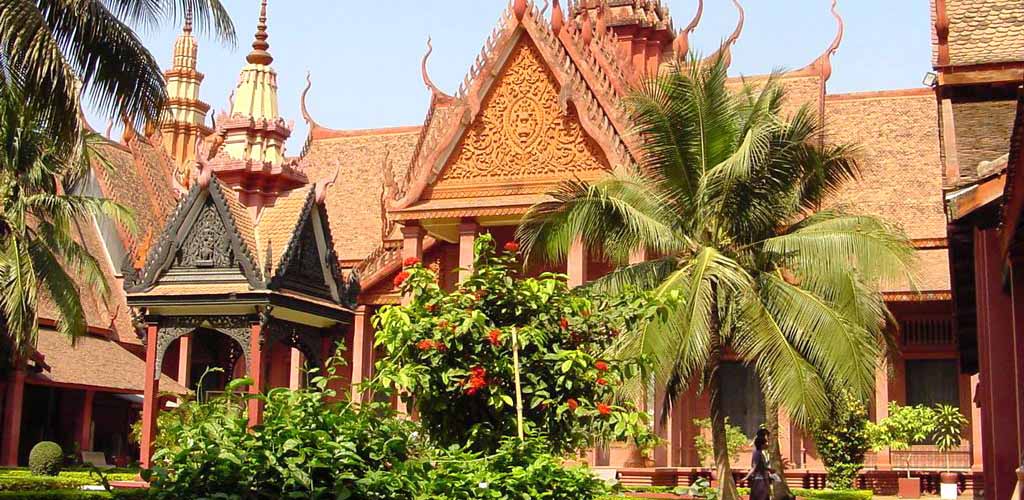
The museum is open daily 0800-1130 and 1400-1730; possibly closed on public holidays. Scaled-down copies of well-known Khmer pieces are on sale at the museum gift shop, the pieces most likely created by students at the adjacent School of Fine Arts. A number of handicraft shops in the area also sell these artifacts.
The description here of the museum's exhibits may not be precise for a number of reasons. Major pieces may be on tour to Paris, New York, or Tokyo, under special arrangement with the museum. The museum's collection will undoubtedly change as renovation proceeds, and there are special exhibitions staged. In 2001, there was an exhibition of stolen statuary that had been returned to
ambodia from abroad.
There are currently more than 400 works in the collection, including massive stone heads from Angkor brought to the museum as late as 1994 for protection from theft. A conservator from the Australian National Gallery, who decided to tackle a flooding problem in the basement, came across 120 unopened crates in the dusty light. Boxes of rare artifacts were rushed by road from ancient temple sites around the country by the Ecole Francaise d'Extreme Orient for safekeeping as civil war escalated in 1970, and were never unpacked. As the museum's collection is documented and photographed, and computer records are compiled, more of Cambodia's treasures may surface. In 1992 a special exhibition of 35 stone and bronze pieces was arranged in Australia, which led to pledges by the Australian government for assistance at the National Museum.
Of special interest at the National Museum are pieces from the Angkor region, moved to this location for safekeeping. If you're going to Angkor, a visit to the museum before (and after) will bring the place to life. Angkor has hardly a single Buddha head left in place, as most have been looted. Small objects are likewise nowhere on display at Angkor, but in the east gallery of the National Museum you'll find display cases filled with exquisite smaller pieces. These include delicate bronze oil lamps and incense holders, some shaped like lotuses, as well as jewelry, silver spittoons, bronze spoons, fine bronze Buddhas heads, hands, fragments, and such rarities as a small quartz lingas from Angkor Thom. The National Museum itself is not immune from headhunters-during the confusion of the 1970s, several pieces were stolen.
The museum is arrayed around a beautiful garden courtyard. At the center of four ponds is a seated statue, originally from the Terrace of the Leper King at Angkor Thom. French archaeologist Groslier noticed marks on the head of the statue and had it removed to Phnom Penh.
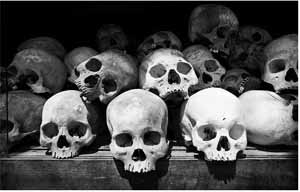 Choeng Ek Killing Fields
Choeng Ek Killing Fields Tuol Sleng Holocaust Museum
This chilling place has been dubbed "Auschwitz on the Mekong." Tuol Sleng and Auschwitz are indeed remarkably similar and remarkably sickening. Genocidal purges targeting those with racial, religious, or other differences are not different today, witnessing the "ethnic cleansing" in Bosnia, Tibet, and Rwanda but what stands out in Cambodia is the sheer scale of the operation in Cambodia and that ethnic Khmers did this to each other. Over 1.5 million people were slaughtered under Pol Pot's genocidal regime. Twenty years on, the Khmer Rouge have never really been brought to justice.
Tuol Sleng, also known as Security Prison 21 (S-21), is a former high school transformed into a detention and interrogation center. Cambodians and their families accused of being "traitors" were brought to S-21. An estimated 14,000-20,000 inmates passed through Tuol Sleng and were tortured to death or killed by summary execution, either here or at Choeung Ek. Mass graves are located in the school grounds. The insane program of extermination extended to former Khmer Rouge cadres and functionaries-and even to the executioners themselves. Incoming prisoners were numbered and photographed on arrival.
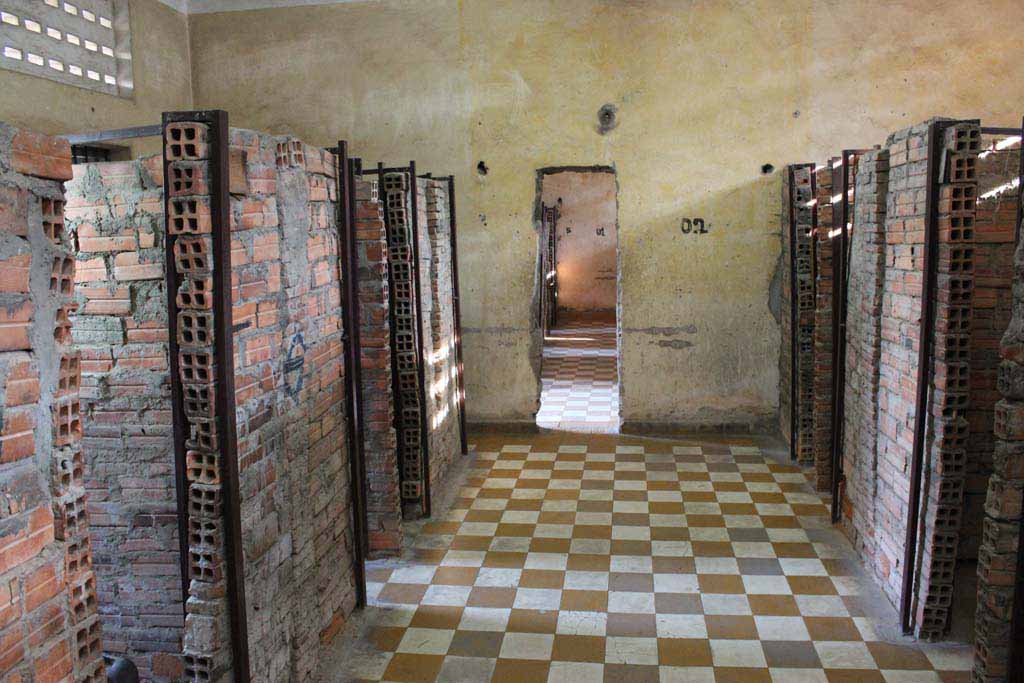
They were violently coerced into writing elaborate confessions of lifelong allegiance to the CIA, KGB, Vietnamese, or all three. The Tuol Sleng manual revealed the sole purpose of torture was to extract these absurd confessions of foreign allegiance. With meticulous efficiency, the confessions were carefully filed away with the black-and-white snap shots of the victims. Then the "traitors" were put to death at Tuol Sleng, or taken to Choeung Ek and executed.
Note: Tuol Sleng is not suitable for children
Military Museum
This small museum is of specialized interest and offers little English labeling. It's located on Norodom Boulevard near the corner of Street 172. There are several salons inside the main building. One shows the fight against the French in 1951, with U.S., French, and Chinese military hardware displayed. Another section concerns the Vietnamese fight against the Khmer Rouge in 1979. There are three sculptures from Angkor War, intercepted from smugglers on the Thai border. A large painting depicts the construction of Angkor.
The Khmer Rouge received the bulk of their supplies from the Chinese. In the courtyard is captured Chinese and Russian equipment: a MiG-19 seized at Pochentong, half a dozen Russian T-58 and Chinese T-59 tanks, a dozen artillery pieces, a Chinese truck, and an army boat used on the Tonle Sap.
Art Galleries
Please request our full list of artists, studios, and galleries on the capital. For collectables, a place not to miss is Mrs. Tan Sotho's Veayobotr, a three-story gallery featuring unique collectables from throughout Asia procured by Mrs. Sotho herself over four decades of travel in the region.
Markets

There's not much of a reason to venture all the way out to visit the touristy Russian Market when many neighborhood markets remain in the heart of the city, including Phnom Penh's Central Market (above), Weekend Market (nearby on Friday and Saturday nights), and our favorite, the Middle Market near the waterfront and Grand Palace.
Meta House German Cambodian Cultural Center
Meta House features a rich calendar of art exhibitions, film, performances, DJ parties and more. No. 47, Street 178 Tel: (855) 97 398 65 00. www.meta-house.com.
Phnom Penh Accommodations
Raffles Le Royal
Arguably Indochina's finest hotel and our favorites. Located on a quiet street on embassy row, the Raffles is the finest hotel in the capital. The renowned historic property with 170 guest quarters divided among an Old World main building and low profile wings overlooking a tree-lined courtyard and 80-foot swimming pool. The Landmark Room and the Personality Suites (actually junior suites), are more atmospheric and named after the hotel's famous guests and distinguished by period artworks and antique furnishings.
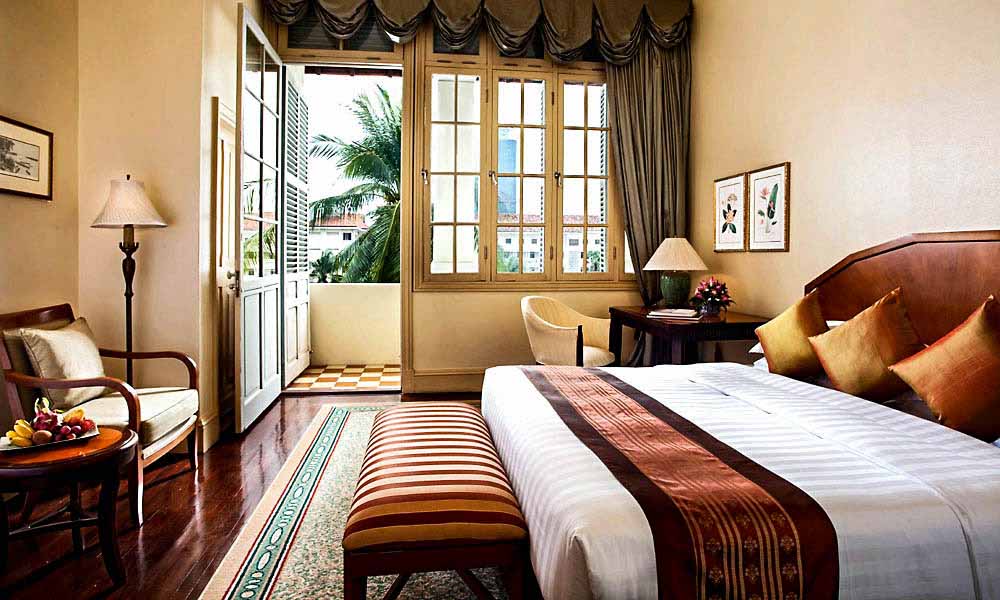
Several appealing dining and cocktail choices include the elegant Restaurant Le Royal, the convivial Writer's Bar and the even more celebrated Elephant Bar. The Amrita Spa includes a fully equipped gym and steam/sauna, as well as a menu of treatments. Unparalleled service will marks your stay here. If you're looking to be closer to action and sights on the waterfront, we recommend the newer Quay or the pleasant Amanjaya (in the panoramic suite).
Phnom Penh Dining (see our full dining list in your pre-tour packet)
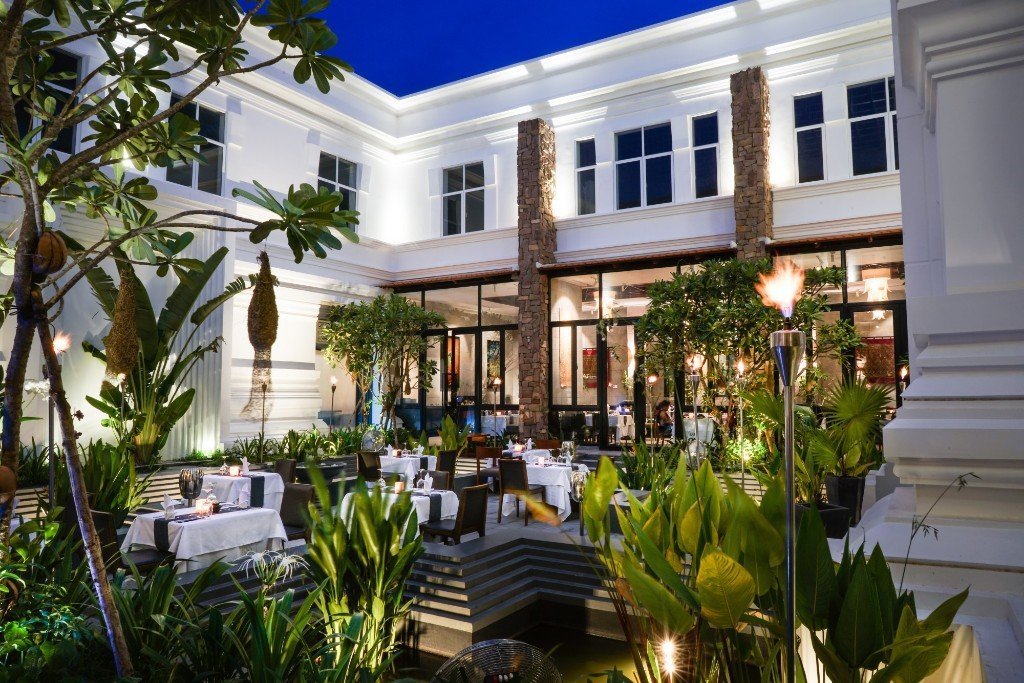
Phnom Penh features elegant dining venues in French-colonial villas (above, Malis restaurant)
Dosa Corner (near the The Place gym (below). Indian favorites, laid back setting. 5E Pasteur.
Sports Bars
Actually, more of a sports lounge, Score is pleasant and stylish with a gigantic 20-foot screen for catching the World Cup or whatever event happens to be occurring during your trip. No. 5 Street 282. Tel: 023 221 357
Gyms
The Place is a 4-story world-class gym with swimming pool, yoga classes, studios and extensive equipment. Located about 15 minutes from the waterfront at #11 Street 51, Sangkat Boeung Keng Keng 1, Khan Chamkarmon. Tel: (855) 23 999 799. Hours: 7 Days a week 6:00 AM to 10:00 PM (9:00 PM weekends).
Casino
Indochina's largest casino, Naga World, is a spectacle on the riverfront, rising like an imposing cathedral dedicated to gamblers. Popular with Chinese gamblers, the complex is nothing special beyond its immense size dominating the riverfront area.
Excursions around Phnom Penh
Around Phnom Penh are a number of destinations within day trip range-nothing special, but a chance to get into the countryside and receive a blast of oxygen after the fetid air of Phnom Penh. With the exception of Choeung Ek, the sites described here are picnicking destinations, popular with the weekend escape crowd. We can arrange unique day tours from Phnom Penh for biking, trekking, boating and other interests.
Choeung Ek
There are killing fields all over Cambodia, skull-and-bone cairns that stand as stark memorials to Khmer Rouge atrocities. At Choeung Ek, 15 kilometers to the southwest of Phnom Penh, an estimated 17,000 people were killed, most clubbed to death to save ammunition. Many were taken from the interrogation center at Tuol Sleng. There are over 120 mass graves in the area; half have been disinterred. A stupas-like tower of glass panels was erected in 1988 to house the grisly remains, with shelf after shelf of skulls-an unnerving sight. Be sure to read the moving visitor book here.
Koki Beach
Koki Beach, about 12 kilometers east of Phnom Penh on the Saigon route, is a popular weekend and public holiday destination. Residents of Phnom Penh decamp to the river and rent huts raised on stilts for a day of picnicking, talking, or romance. Cafes here sell grilled fish and chicken. Don't expect much in the way of a beach, though there is a strip of sand and it is possible to swim. Most visitors rent a stilt hut to take a nap, ward off the heat, or counter the floodwaters of the monsoon season. You can hire a boat to tour the lake; waterborne vendors come alongside to sell food. Crowded on weekends, with lots of food vendors, but nothing much happening during the week. Share-taxis run to Koki Beach from a stand near Chbam Pao Market on the east side of Monivong Bridge; you could also take a moto.
Udong
Udong, 40 kilometers northwest of the capital along Route 5, is the site of an ancient capital, with a cluster of kings' tombs. This is another popular picnic site, affording great views of the surrounding area. Udong was the seat of Cambodian kings from 1618 to 1866. Almost all the buildings of the former royal city were razed when Lon Nol launched air strikes against Khmer Rouge hideouts in the 1970s; other sites were later blown up by the Khmer Rouge. A Khmer Rouge prison was located here. A memorial to the victims was erected in 1982, with torture devices and bones from mass graves on display, as well as murals depicting Khmer Rouge atrocities.
Tonle Bati
About 33 kilometers south of Phnom Penh on Route 2 is a turnoff that leads several kilometers to Tonle Bati. This is a popular picnic spot, with a lake and two temples, Ta Prohm and Yeay Peau. On weekends the place is full of food stalls and picnic paraphernalia. Amputee beggars demanding money sometimes try to stop cars coming into the area.
Twelfth-century Ta Prohm Temple look, similar to a minor Angkor temple. Some tribute the handiwork to King Jayavarman VII, who ruled in Angkor from 1181. According to legend, the temples were built by Ta Prohm. While traveling through Tonle Bati, an Angkor king fell in love with Yeay Peau, the beautiful daughter of a fisherman. The king passed three months with her and she became pregnant. Upon leaving, the king gave her a ring with instructions to send the child she bore to Angkor. When her son, Prohm, duly presented the ring at Angkor, he was welcomed at his father's palace and given an education. The king later sent him back to govern Takeo province. Prohm built a temple similar to those he'd seen at Angkor, and named it after himself. For his mother, he built Yeay Peau Temple.
Phnom Chisor
Some 20 kilometers south of Tonle Bati is a hilltop ruin dating from the Angkor period. The turnoff to Phnom Chisor is 55 kilometers south of Phnom Penh; the temple is about four kilometers from Route 2. The main sanctuary-what's left of it-is an 11th-century structure dedicated to Brahma. This spot is isolated, so do not go alone. Bring a guide. The temple is reached by a staircase on the northern side of the hill. From the top are expansive views over the countryside-you can see two other temple ruins to the east. Leave the hilltop by the southern staircase.
Takeo
The town of Takeo is 75 kilometers south of Phnom Penh on Route 2. It can also be reached by Route 3; this way is 87 kilometers from Phnom Penh, but the road is in better shape. This is stretching the limits of a day trip from the capital because travel time alone is six hours round-trip by taxi. About 20 kilometers east of Takeo is the modern village of Angkor Borei, which is thought to have been the site of Vyadhapura, the last capital of the Funan Kingdom. South of town is a hill called Phnom Da. Statues discovered in caves at Phnom Da by French archaeologists are displayed at Phnom Penh's National Museum. The Phnom Da style was identified as the first stage of pre-Angkorian art. On top of Phnom Da is a small building made from heavy basalt blocks.

Ready to plan your trip to Cambodia? View our Cambodia Tours or fill out a short contact form by clicking below or calling us in San Francisco at (415) 418-6800 .
